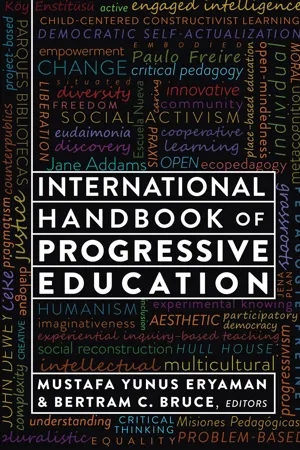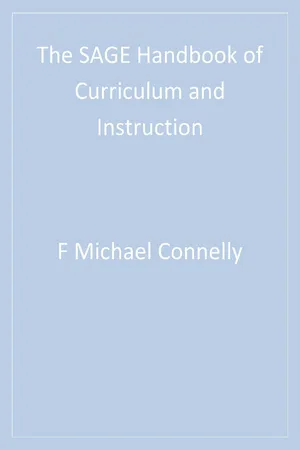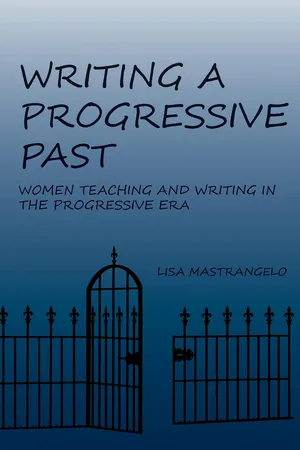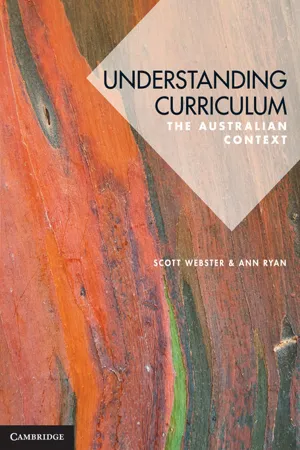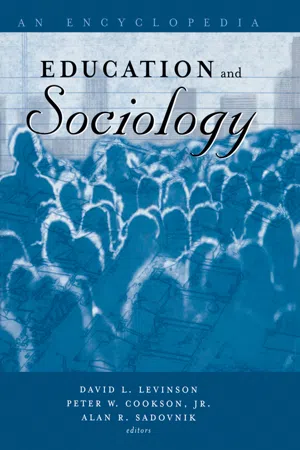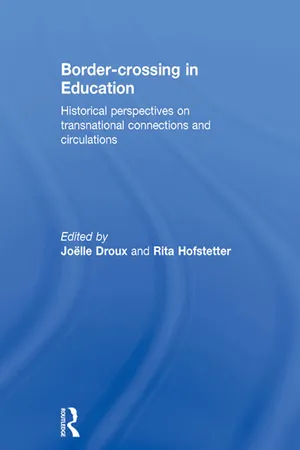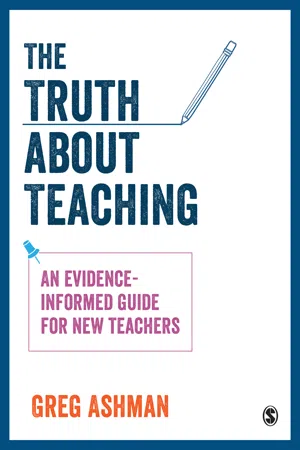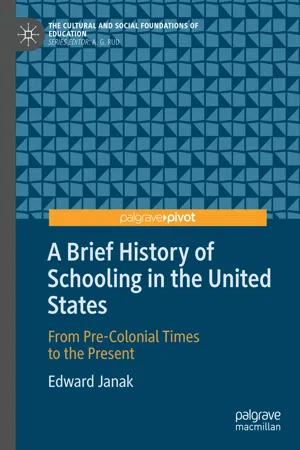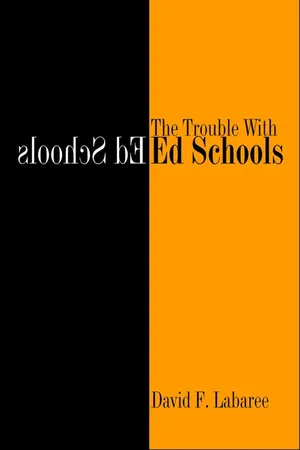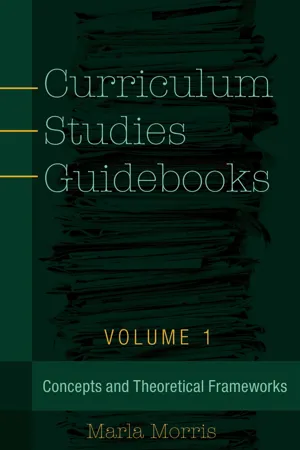History
Progressive Education
Progressive education is an educational philosophy that emphasizes learning through experience, critical thinking, and problem-solving. It emerged in the late 19th and early 20th centuries as a response to traditional, authoritarian teaching methods. Progressive educators advocate for a more student-centered approach, focusing on individual needs and interests to promote active engagement and holistic development.
Written by Perlego with AI-assistance
Related key terms
1 of 5
12 Key excerpts on "Progressive Education"
- Mustafa Yunus Eryaman, Bertram C. Bruce(Authors)
- 2016(Publication Date)
Note. Originally phrased principles can be found in The Transformation of the School: Progressivism in American Education 1876–1957 by L. Cremin, 1961, pp. 243–245. PAST | 57 Today, Progressive Education is viewed as “a pedagogical movement that empha- sizes student-centered learning experiences and that incorporates aspects such as learning by doing, valuing diversity, integrated curriculum, problem-solving, crit- ical thinking, collaborative learning, social responsibility, democracy, and lifelong learning” (Pecore & Bruce, 2013, p. 10). As in the early 1900s, progressive edu- cation today means different things to different people. For example, while some Progressive Education schools focus on learning by projects and others focus on social justice, the important common feature is the situation of learning within a social, community, or political context that some progressive educators may more broadly use to actively promote critical pedagogy and democratic education (Pecore & Bruce, 2013). T H I S S E C T I O N In this first section within the International Handbook of Progressive Education, we include 10 chapters that explore the legacy of Progressive Education by drawing on the history of Progressive Education as a way of looking at relevant present-day educational issues and, in that context, engage in critical dialogue about the aims of education. Two chapters address the role of critical discourse in higher educa- tion and teacher preparation. Others examine Progressive Education reform initia- tives and visions to provide historical context for the aims of progressive educa- tion, including efforts both within and beyond the U.S. Further chapters focus on specific trends, such as project-based learning, issues-centered education, aesthetic education, or wonder. We first present two chapters addressing the role of critical discourse in higher education and unique perspectives on teacher preparation.- F. Michael Connelly, Ming Fang He, JoAnn Phillion(Authors)
- 2007(Publication Date)
- SAGE Publications, Inc(Publisher)
This confronta-tion will provoke both skepticism and sympathy regarding progressive ideals. Ultimately, we find that it leads to a renewed, critical appreciation for the potential that progressive thought has for curriculum in our time. T HE P ROGRESSIVE T RADITION IN C URRICULUM : A B RIEF R EFRESHER Educational historians disagree about the origins of Progressive Education, about who was a progressive educator, and about how connected proponents were with the political and social Progressive Movement of the late 19th and early 20th centuries (Cremin, 1961; Graham, 1967; Kliebard, 2004; Palm, 1940; Schubert, 2002). Nonetheless, historical research makes it possible to sketch guiding purposes and methodologies of Progressive Education. Pioneers in the movement believed that schools had a duty to individuals and society that went beyond the teaching of tra-ditional academic subjects (Paulay, 1942). Joseph Rice’s famous “expose” of the sluggish nature of American schooling, published in 1893, gave an enormous impetus to the call for reform (Kliebard, 2004). Parents, educators, and other members of the public introduced a wide array of educational innovations and ideas (Cremin, 1961; Reese, 1986). Some of the best known pro-gressive reforms were developed by educational theorists. Heavily influenced by revolutionary developments in science, industry, and commu-nications, progressive theorists strove to create curriculum that would draw together students, subject matter, and societal improvement. Kliebard (2004) categorizes progressive re-formers into three categories, each with a distinc-tive bent toward curriculum development: the child-study movement, the social efficiency move-ment, and the social reconstructionist movement. Reformers within the child-study movement sought to create curriculum that respected the child’s developmental stages.- eBook - PDF
Writing a Progressive Past
Women Teaching and Writing in the Progressive Era
- Lisa Mastrangelo(Author)
- 2012(Publication Date)
- Parlor Press, LLC(Publisher)
3 1 John Dewey and Progressivism No experience is educative that does not tend both to knowledge of more facts and entertaining of more ideas and to a better, a more orderly, arrangement of them. — John Dewey The object of education is social improvement. Education is really needed for the purpose of making better citizens. This is practically the same thing as the higher end, so-cial progress, which we saw to be the condition to increase human happiness. If education cannot accomplish this end, it is worth nothing. —Lester Frank Ward In developing a critical imagination with a subject, it is vital to under-stand the context in which my research subjects lived and worked. As Kirsch and Royster ask, “How do we transport ourselves back to the time and context in which they lived, knowing full well that it is not possible to see things from their vantage point?” (648). While we can-not recreate their vantage point, in order to try to understand it with greater clarity it is important to foreground my discussion of Sophie Chantal Hart and Clara Stevens with a conversation about progres-sivism, and in particular, progressive teaching practices. Particularly because progressivism is so difficult to define, any discussion of pro-gressive teaching practices must be framed with a discussion of the different types of progressivism and their importance to my argument. Doing so allows me to better situate myself critically with my material and to create a more complex picture of it. The Progressive Era is a rich and vital time to critically imagine. In the late nineteenth century, as part of the Progressive Movement, education through schooling was touted as a powerful method for cur- Writing a Progressive Past 4 ing social ills. In addition to the establishment of public schools, so-cial conditions, especially those of the poor, were scrutinized. - eBook - PDF
Understanding Curriculum
An Australian Context
- Scott Webster, Ann Ryan(Authors)
- 2014(Publication Date)
- Cambridge University Press(Publisher)
In this chapter about progres- sive approaches to curriculum we will follow William Pinar, who said that curriculum theory is ‘about discovering and articulating for oneself and with others, the edu- cational significance of the school subjects for self and society in the ever-changing historical moment’. 4 What follows is a discussion relating how progressive educators were (and are) engaged in this quest for educational significance. Understanding Curriculum 44 There is no single, agreed definition of what it is to be a progressive educator; indeed, as we make our acquaintance with those who describe themselves, or have been described by others, as progressive educators we will see that the meaning(s) for the term are based on a wide range of interpretations. In the early years Rueben Palm suggested that ‘the term progressive has been used in a general sense to denom- inate educational reformers who protested against methods of instruction which they regarded as vain, memory cramming, formal and utterly out of keeping with the nat- ural development of children’. 5 Progressive approaches make use of critical frameworks and are viewed as an alternative to standardised testing regimes and test-orientated instruction found in national curriculum and related policies, teacher registration and evaluation pro- cesses. Reflecting Rousseau’s ideas, they remain concerned with interrogating the nature of knowledge and its emancipatory possibilities in an engagement in learning how to live, learning how to be human. 6 Progressive approaches describe a curricu- lum focus beyond models and designs, to an understanding of curriculum as a lived experience. Reflective activity 3.2 As you read through this chapter take particular note of the language progressive educators use to describe their work. Also, pay attention to how they understand the purposes of their work and how this relates to education. Compare their language and purposes to those of the more traditional approaches. - eBook - ePub
Education and Sociology
An Encyclopedia
- David Levinson, Peter Cookson, Alan Sadovnik(Authors)
- 2014(Publication Date)
- Routledge(Publisher)
Perhaps these debates can be best understood by examining reform cycles of the twentieth century, which revolved between progressive and traditional visions of schooling. On the one hand, traditionalists believed in knowledge-centered education, a traditional subject-centered curriculum, teacher-centered education, discipline and authority, and the defense of academic standards in the name of excellence. On the other hand, progressives believed in experiential education, a curriculum that responded to both the needs of students and the times, child-centered education, freedom and individualism, and the relativism of academic standards in the name of equity. Although these poles and educational practices rarely were in only one direction, the conflicts over educational policies and practices seemed to move back and forth between these two extremes. From 1945 to 1955, the Progressive Education of the previous decades was critically attacked.These critics, including Mortimer Smith, Robert Hutchins, and Arthur Bestor, assailed Progressive Education for its sacrificing of intellectual goals to social ones. They argued that the life adjustment education of the period combined with an increasingly antiintellectual curriculum destroyed the traditional academic functions of schooling. Arthur Bestor, a respected historian and a graduate of the Lincoln School, one of the early progressive schools in New York City, argued that it was “regressive education” not Progressive Education that had eliminated the school’s primary role in teaching children to think (Ravitch, 1983:76). Bestor, like the other critics, assailed the schools for destroying the democratic vision that all students should receive an education that was once reserved for the elite. He suggested that the social and vocational emphasis of the schools indicated a belief that all students could not learn academic material. In an ironic sense, many of the conservative critics were agreeing with the radical critique that the Progressive Era distorted the ideals of democratic education by tracking poor and working class children into nonacademic vocational programs.Throughout the 1950s the debate between progressives who defended the social basis of the curriculum and critics who demanded a more academic curriculum raged on. What was often referred to as “the great debate” (Ravitch, 1983:79) ended with the Soviet launching of the space satellite Sputnik. The idea that the Soviets would win the race for space resulted in a national commitment to improve educational standards in general and to increase mathematical and scientific literacy in particular. From 1957 through the mid-1960s, the emphasis shifted to the pursuit of excellence and curriculum reformers attempted to redesign the curricula in ways that would lead to the return of academic standards (although many doubted that such a romantic age ever existed). - eBook - PDF
Irma
A Chicago Woman's Story, 1871-1966
- Ellen Fitzsimmons Steinberg(Author)
- 2004(Publication Date)
- University Of Iowa Press(Publisher)
4 Then American educators, attending to children’s needs for early educational experiences, incorporated the ideas of Friedrich Froebel (1782–1852) about kindergarten into the system. Finally, at the start of the twentieth century, educational reformers mixed in the idealism of Ralph Waldo Emerson (1803–1882), the pragmatism of William James (1842–1910), and the scientific emphasis of Herbert Spencer (1820 – Reflections on Education, 1875–1891 . . . . . . . . . . . . . . . . . . . . . . . . . . . . . . . . . 3 1903) to create an unique American philosophical and pedagogical system called progressivism. Progressivism was more than a political movement; it was more than an educational movement. Its approach to life and learning was in marked contrast to earlier educational approaches rooted in social efficiency, ones that emphasized classroom control and management within a struc-tured curriculum that focused on basic skills. Instead, progressivism en-compassed a concern with social life and cut across many sectors of American society. Its theories and philosophical applications were in-volved with the public nature of institutions and aesthetic innovations. 5 The Progressive Movement stressed two basic principles: continuity and interaction. In other words, each learning experience was to be nurtured by the previous experience, and everything learned was subject to revi-sion based upon later learning. Progressivism promoted independent thinking, creativity, and expres-sion of feeling. It was geared to direct the evolution of society toward so-cially desirable ends. Progressivists assumed that science was the method by which this evolution could be brought about. The development of in-telligence, morals, and values was considered crucial for this endeavor. - eBook - ePub
Border-crossing in Education
Historical perspectives on transnational connections and circulations
- Joëlle Droux, Rita Hofstetter(Authors)
- 2018(Publication Date)
- Taylor & Francis(Publisher)
A tendency exists among some historians of education in the US to depict traditional academic curricula positively and Progressive Education negatively, to misrepresent Progressive Education by overstating its faults or understating its accomplishments, to accept uncritically criticisms of Progressive Education, to interpret Progressive Education through its critics, and even to employ scare quotes and pejorative language when describing Progressive Education. Together these tendencies comprise a strain of condescension toward Progressive Education in history of education scholarship in the US. In comparison, English historians of education tend to provide a balanced account of the successes and failures of Progressive Education, implicitly and explicitly endorse Progressive Education and provide sharp criticism of conservative critics of progressivism. English historians of education tend to treat Progressive Education with critical sympathy. It is almost as if English historians of education write about progressivism in the style of a White Paper, while some US historians of education tend to write about Progressive Education more in the style of a Black Paper. A compelling explanation for these dissimilarities in interpretation can be found in the differences in the institutional contexts and the status of the field of history of education in the US and England. Let us first turn to the US scene.The strain of condescension toward Progressive Education in history of education scholarship in the US appeared during a definitive period in the life of that field. Cohen reported that the emphasis on serving professional educators established during the early twentieth century by Ellwood Cubberley and Paul Monroe was reinforced during the 1930s by social reconstructionist educators who sought to put the school in the service of resolving social problems. From this context emerged “social foundations of education” as a concerted effort to integrate and apply foundational disciplines, including philosophy, psychology, sociology and history, to prepare professional educators to view the school as a vehicle of social change. By the 1950s this functional role of foundations of education was firmly entrenched in colleges of education in the US. History of education scholarship aimed at contributing to the practical and professional mission of the foundations of education. - eBook - ePub
The Truth about Teaching
An evidence-informed guide for new teachers
- Greg Ashman(Author)
- 2018(Publication Date)
- SAGE Publications Ltd(Publisher)
And it is important that we pay Progressive Education its due, follow Dewey’s example and describe it as a ‘philosophy’ rather than think of it as a bag of teaching tricks. Progressive Education starts from principles and then selects curricula, teaching methods and even the objectives of education accordingly. Progressive Education is ultimately about what educators believe education is rather than any classroom task. Progressive Education is not progressive politics. Instead, it represents a philosophy of learning that can be adopted regardless of political views. Although currently a default position of many on the political left, perhaps due to its name, Progressive Education was once the philosophy of Giovanni Gentile, Mussolini’s education minister. As such, it drew criticism from the Marxist philosopher Antonio Gramsci (Mayo, 2014). Progressivism tends to emphasise the individual, something that is often more a concern of the political right. And it is important to note that a belief that education is about the unfolding of a natural plan does not compel us to believe that everyone has the same natural plan. Some students may be naturally fitted for leadership and others for factory work. This is the implication of any argument in favour of nurturing individual talents (e.g. Robinson, 2017). There are many teachers who, if asked, would claim no educational philosophy. They would insist that they are pragmatists who draw upon different methods and tactics as required. But this is not true. Everyone has a set of beliefs about teaching, even if they lie largely hidden. You either believe that education should be a natural process, like the unfolding of a flower, or you do not. You cannot believe this for some of the time or for part of a lesson - eBook - ePub
A Brief History of Schooling in the United States
From Pre-Colonial Times to the Present
- Edward Janak(Author)
- 2019(Publication Date)
- Palgrave Pivot(Publisher)
Eventually, there were distinct camps within the Progressive Education movement. One group, the child-centered progressives, focused on overhauling the practices of teaching—the curricula, pedagogy, and management. A group of progressive scholars came together in 1919 to form the Progressive Education Association (PEA), a group whose mission was “reforming the entire school system of America.” Beyond Dewey, progressive thinkers included William Heard Kilpatrick, who in 1913 invented the project method. Kilpatrick defined the project as a purposeful act that demonstrates a worthy life in a democratic society. He presented four types of projects in which students could engage: they could embody some idea or plan (make something), enjoy some aesthetic experience (appreciate something), solve some problem (fix something), or obtain some degree of skill (learn to do something). Another example was Hilda Taba, a student of John Dewey, who focused on development of curriculum. Taba encouraged teachers to become mediators rather than lecturers, to lead the discussion rather than predetermine the curriculum. Today, Taba’s focus on collaboration is alive and well within the classroom, reflected through educators who employ critical pedagogy to account for dynamics of power and privilege that have traditionally placed instructors in positions of power over students. In a successful attempt at proving that their ideas were solid, the PEA launched the Eight-Year Study, in which students in 30 high schools across the United States were taught using completely progressive techniques. There was no set curriculum, no set courses, no set texts, and so on. The study mapped university progress of students from this system compared with their peers from more traditional schools. The results were that students from the progressive school were advanced socially and on par academically - eBook - ePub
Humanistic Teacher
First the Child, Then Curriculum
- Jerome S. Allender, Donna Sclarow-Allender, Donna Sclarow Allender(Authors)
- 2015(Publication Date)
- Routledge(Publisher)
The year 1950, at half century, was a good marking point for strengthening one’s belief in the American dream. If the era around this year had a theme, it was agency. The planet had survived World War II, the wonders of science abounded, and there was plenty of optimism in the air. It was a time to imagine the realistic possibility of creating a more perfect world. Obstacles were abundant too, including intractable ones, but the mood was essentially unaffected by them. Even a discouraged teacher would have been much less gloomy than we were as students, and it was more likely that many teachers were excited about the potential of education for transforming society and guiding children in ways that could well benefit them in the world of their future.Paradoxically, this was when the Progressive Education Association was dying, indeed demised by the mid-1950s. It wasn’t long before Lawrence Cremin (1961) offered a positive interpretation: “granted the collapse of Progressive Education as an organized movement, there remained a timelessness about many of the problems the progressives raised and the solutions they proposed” (p. 352). The philosophy had its beginnings in the late 1800s; because of its ongoing success, without difficulty a national association was formed in the winter of 1918–1919. Over the next three decades, the influence of Progressive Education continued to expand. But by 1950, so much of Dewey’s philosophy had affected teaching and learning in U.S. schools, it was no longer necessary to join a radical group to benefit from the fruits of those who had done the pioneering. For Cremin, “Progressive Education had become the conventional wisdom of the fifties” (p. 352). This meant that schools included programs that were designed to improve health, prepare for an occupation, and care for the quality of family and community life. The focus of education included significant attention to children of different interests and abilities. The aims of Progressive Education stood for a free and full development of each individual child, and this attitude toward education had quite thoroughly imbued the culture of U.S. schools. - eBook - PDF
- David F. Labaree(Author)
- 2008(Publication Date)
- Yale University Press(Publisher)
The Ed School’s Romance with Progressivism 144 We already know the aims and ideals of the pedagogical group, from our close examination of the ed school’s progressive vision. 49 The focus of this strand of progressivism was on the teaching and learning process within the classroom. As we have seen, pedagogical progressives wanted to base instruction on the needs, interests, and developmental stage of the child; to develop a curriculum that focused on teaching students the skills they need in order to learn any sub-ject instead of one focused on transmitting particular bodies of knowledge; to promote discovery and self-directed learning by the student through active en-gagement; to have students work on projects that express student purposes and that integrate the disciplines around socially relevant themes; and to promote values of community, cooperation, tolerance, justice, and democratic equality. As befits a movement driven by ideas and exerting its greatest impact on educa-tional thought, it drew heavily from a wide array of intellectual precursors, in-cluding Jean-Jacques Rousseau, Friedrich Froebel, Heinrich Pestalozzi, Johann Herbart, Horace Mann, Edward Sheldon, and William James. Major actors in the movement included Francis W. Parker, John Dewey, G. Stanley Hall, William Heard Kilpatrick, George S. Counts, Harold O. Rugg, and Boyd H. Bode. Hall’s contribution was to develop the field of child study in psychology using scientific methods, which granted credibility to the idea of adapting education to the needs of the child, focusing on stages of develop-ment, and building education on the child’s impulses and interests. Kilpatrick took the lead in promoting the project method, which came to embody many of the elements of the pedagogical progressive creed (the activity curriculum, the experience curriculum), and in the process helped make Teachers College the prime mover in the progressive movement. - eBook - PDF
Curriculum Studies Guidebooks
Volume 1- Concepts and Theoretical Frameworks
- Marla B. Morris(Author)
- 2016(Publication Date)
If we are to understand our Progressive roots curriculum theorists must always return to Dewey. Our Progressive Inheritance: The Debate and Controversy One of the best books on the Progressive movement of education is Lawrence Cremin’s (1961) The Transformation of the School: Progressivism in American Education 1867–1957. First, Cremin suggests that he does not have a good definition of Progressive Education because the movement was “frequently, 104 curriculum studies guidebooks contradictory” (p. x). And second, he states that he is writing a “social and intellectual history” (p. x), suggesting that American Progressive Education was clearly part of a much larger response to industrialism, and that while the Ameri- can movement proceeded in terms of the American experience, many of its elements were similar to, and indeed, influenced by, contemporary developments in other industrial nations. (p. x) Cremin does exactly what Dewey calls for: he contextualizes his study of the “transformation of the school” against the larger backdrop of the movement of progressivism in American politics. It is important to follow up on Cre- min’s advice by trying to understand the larger American progressive move- ment before talking about what Progressive Education meant in the early 20th century. Here I touch on some key aspects of progressivism to better understand how education fits into the larger social scene and explore the historical relation that reconceptualization has with this larger Progressive movement. Scholars might agree on certain aspects of American progressiv- ism as a political movement in the early 20th century, but there are many disagreements as to who was and was not a Progressive. Richard Hofstadter (1955) makes an interesting point about American progressivism writ large.
Index pages curate the most relevant extracts from our library of academic textbooks. They’ve been created using an in-house natural language model (NLM), each adding context and meaning to key research topics.
